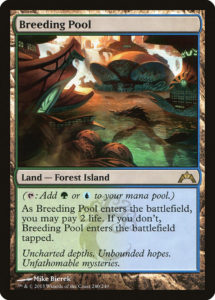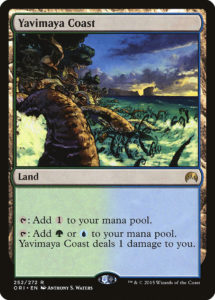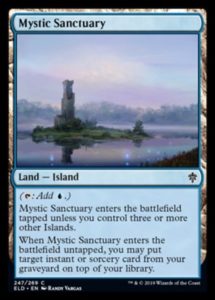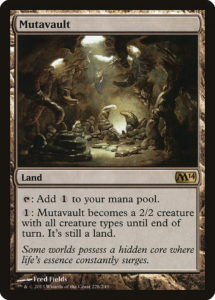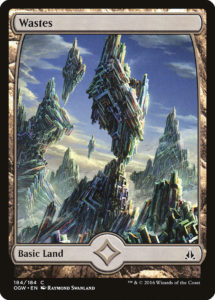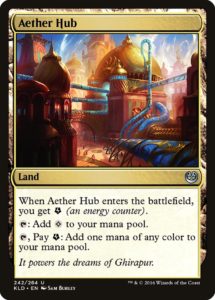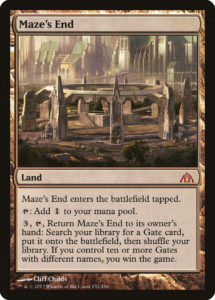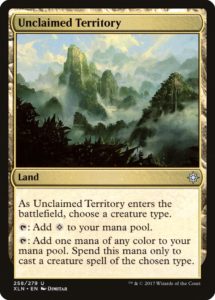Pioneer was announced yesterday. Just as Vintage begins with cards from 1993 and Modern begins with cards from 2003, Magic’s newest format begins with cards from 2013. Pioneer will be pushed in a big way at the tournament level, just as Modern was at the beginning of the decade. Other than the five fetch lands from Khans, everything is legal.
Now is the time for exciting speculation about what is possible in Pioneer. Not only might Pioneer feature Standard decks with banned cards like Copycat, Mardu Vehicles, and BG Delirium; it will also power up archetypes, such as HazoRed with Monastery Swiftspear, Eidolon of the Great Revel, and Stoke the Flames. There’s also the various combos that weren’t quite good enough to be played in Modern but never coexisted in Standard.
Of course, for any of this to happen, mana must be involved. There are a variety of mana fixers available in Pioneer. Understanding what mana is available can tell players not only how they can stretch their manabases and what utility lands they can fit in, but also what will be harder to do. Today, we’ll be covering all of the major dual land cycles and utility lands in Pioneer.
The Universal Stuff
We’ll start with the things that all color pairs have access to. If you discount weaker cycles like Cinder Barrens and Bloodfell Caves, there are three ten-card cycles of dual lands:
Shocklands (Blood Crypt and friends)
Check lands (Dragonskull Summit)
Temples (Temple of Malice)
These three cycles are very powerful. Even though shock lands lose a ton of power with the preemptive banning of the Khans fetches, they’re still very powerful and synergize with the check lands and Throne of Eldraine common lands (which check for basic land types).
In addition, everyone has access to Fabled Passage and its much weaker cousin, Evolving Wilds (but not Terramorphic Expanse). Mana Confluence is the other powerful rainbow fixer, but it wouldn’t be surprising if there are some busted interactions with Lotus Field.
Unequal Distribution
Several cycles of land are not available to all color pairs. Magic has tended to introduce new cycles of lands in allied colors (in the early days, there were very few enemy lands). This led to enemy color pairs eventually receiving their versions of existing land cycles while more new ally color land cycles were made. This pattern yields an unequal distribution of land cycles in Pioneer.
Enemy colors have three cycles that likely favor more aggressive decks:
Pain lands (Battlefield Forge)
Fast lands (Inspiring Vantage)
Zendikar Creature lands (Needle Spires)
Because Tenth Edition, Scars of Mirrodin, and Worldwake aren’t in Pioneer, the allied versions of these lands are unavailable. Moreover, tricolor players have access to the Khans of Tarkir trilands but not the Shards versions. However, while the enemy color lands provide slightly more tools to faster decks, allied color lands provide potent and more painless tools to midrange and control decks:
Cycling lands (Fetid Pools)
Tango/Battle lands (Sunken Hollow)
Reveal lands (Choked Estuary)
Each allied color pair has access to twelve dual lands with basic land types, making it fairly facile to play two color decks alongside cards like Mystic Sanctuary.
Monocolor utility lands
There are plenty of single-color lands that fit into decks that aren’t stretching their mana bases too thin.
Nykthos, Shrine to Nyx (less a utility land and more a massive monocolor reward in the right deck)
Blighted Cataract (technically, this cycle is colorless, but it only fits in a deck that can use the ability)
And perhaps most importantly, Ramunap Ruins is back!
Mono-black gets two extra goodies in the combination of Cabal Stronghold and Urborg, Tomb of Yawgmoth. Combine those with Nykthos for extra fun!
Colorless Utility Lands
Decks that can stretch their manabases can benefit from a variety of lands which trade colored mana for big benefits.
Mutavault is a very powerful Magic card and probably one of the most important lands in Pioneer. For a relatively low cost, decks get free creatures.
Mobilized District is the weaker version, but is still notable.
Field of Ruin (to keep the format fair)
Field of the Dead (to keep the format unfair)
Thespian’s Stage (hoping that Wizards makes a mistake in the future)
Drownyard Temple (probably too slow and definitely too cool)
The Eldrazi Package
In addition to the enemy pain lands and colorless utility lands, there are a wealth of options for those looking to play Thought-Knot Seer, Reality Smasher, and friends.
Ruins of Oran-Rief (which could also go in go-wide artifact decks)
Many of these cards coexisted in Standard when there wasn’t much of an Eldrazi deck, but perhaps Eldrazi could combine with the plethora of potent artifacts and colorless Planeswalkers to overcome the lack of Eldrazi Temple.
Energy + Artifacts
Energy is back, and so is the possibility of powerful artifact decks (perhaps finally combining Treasure, Food, and Clue tokens in one place).
There haven’t been a ton of artifact sets in Pioneer, but never discount the power of cards like Steel Overseer and Ensoul Artifact. Furthermore, many of the Eldrazi lands can be slotted right into colorless-heavy artifact decks.
Guildgates never go out of style
Guildgates have been wreaking havoc on Standard, so why not keep playing them alongside Field of the Dead in Pioneer? Moreover, why not add in Maze’s End for a slower combo that literally wins the game on the spot?
Tribal Lands
While there’s no Ancient Ziggurat or Cavern of Souls to enable a full rainbow Humans (or Spirits, Elementals, etc.) manabase, Unclaimed Territory is a solid start (and works alongside the more painful Mana Confluence). If you’re game to go with a classic Magic tribe, Sliver Hive is happy to oblige.
And that’s where we’ll conclude this dive into the possible lands we’ll see in Pioneer. There are plenty more options. While I’d love to see a Dragon Control deck using Haven of the Spirit Dragon, Hostile Desert get its day in the sun, Hanweir Battlements to meld, or someone to figure out how to make Command Tower work (which is Standard legal, thanks to Brawl); lines had to be drawn somewhere.
Here’s looking forward to seeing what this week’s Magic Online Pioneer tournaments bring and to hopefully get to play some Pioneer at my local game store!
And, as always, thanks for reading.
—Zachary Barash is a New York City-based game designer and the commissioner of Team Draft League. He designs for Kingdom Death: Monster, has a Game Design MFA from the NYU Game Center, and does freelance game design. When the stars align, he streams Magic (but the stars align way less often than he’d like).
His favorite card of the month is Heraldic Banner. It combines mana ramp/fixing (which normally controlling and goodstuff decks want) with a color-specific anthem (which is what monocolor aggressive decks want). There’s a lot of power there, but it presents a deckbuilding puzzle for players to find a solution to. It’s also the perfect kind of puzzle to include in Throne of Eldraine, since the format is defined by finding balance among ambitious monocolor mana requirements. And okay, it also works perfectly with Unlikely Alliance.

